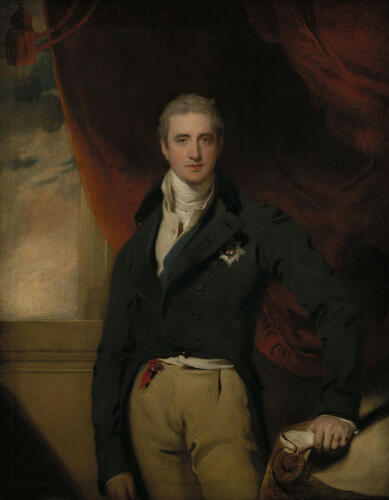Robert Stewart (1769-1822), Viscount Castlereagh, later second Marquess of Londonderry 1816-30
Oil on canvas | 140.2 x 109.5 x 2.5 cm (support, canvas/panel/stretcher external) | RCIN 404934
-
Lawrence was the most fashionable and also the greatest portraitist of his generation. He was made Principal Painter to George III in 1792 after Reynolds’s death, and received occasional commissions; however it was only after 1814 that George IV began to employ him in earnest.
This portrait was commissioned by George IV at a cost of 200 guineas; it is an autograph replica of Lawrence’s portrait of Castlereagh exhibited at the Royal Academy in 1814 and now in a private collection. The replica was paid for in 1817 but remained with the artist until his death; it seems always to have been intended for what became the 'Waterloo Chamber' and celebrates the sitter's achievement as Secretary of State for War in 1805 and 1807-9, during which time he was strongly supportive of the future Duke of Wellington, and in particular his role as Foreign Secretary (1812-22) during the ‘Congress Years’ (he was British plenipotentiary at the Congress of Vienna). Castlereagh wears the riband and star of the Order of the Garter, standing by a table on which he rests his left hand, in which he holds a paper.
The Waterloo Chamber is a great hall on the public route at Windsor Castle displaying portraits of those soldiers, sovereigns and diplomats responsible for the overthrow of Napoleon and the re-establishment of the monarchies and states of Europe thereafter. The concept began in 1814 when George IV used the opportunity of the Treaty of London to commission Lawrence to paint distinguished visitors. The group of portraits grew during the next decade as Lawrence continued to obtain portrait sittings at the various congresses following the Battle of Waterloo in 1815 and, in some cases, by making special journeys. Most of the twenty eight portraits were delivered after his death on 7 January 1830. By this time work was already begun of the space of the Waterloo Chamber created by covering a courtyard at Windsor Castle with a huge sky-lit vault; the room was completed during the reign of William IV (1830-7). The first illustration of the interior is provided by Joseph Nash (1809-78) in 1844 (RCIN 919785) and shows the arrangement which survives to this day: full-length portraits of warriors hang high, over the two end balconies and around the walls; at ground level full-length portraits of monarchs alternate with half-lengths of diplomats and statesmen.Provenance
Painted for George IV for 150 guineas; added to the inventory of Carlton House dated 1819 (no 659); taken to the Waterloo Chamber at Windsor Castle
-
Medium and techniques
Oil on canvas
Measurements
140.2 x 109.5 x 2.5 cm (support, canvas/panel/stretcher external)
141.0 x 110.0 cm (support, canvas/panel/stretcher external)
138.3 x 108.8 cm (sight)
140.0 x 109.2 cm (sight)









